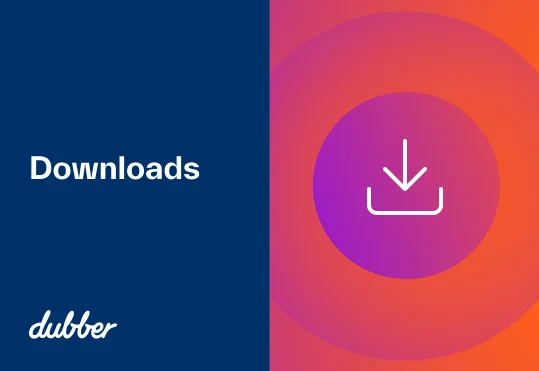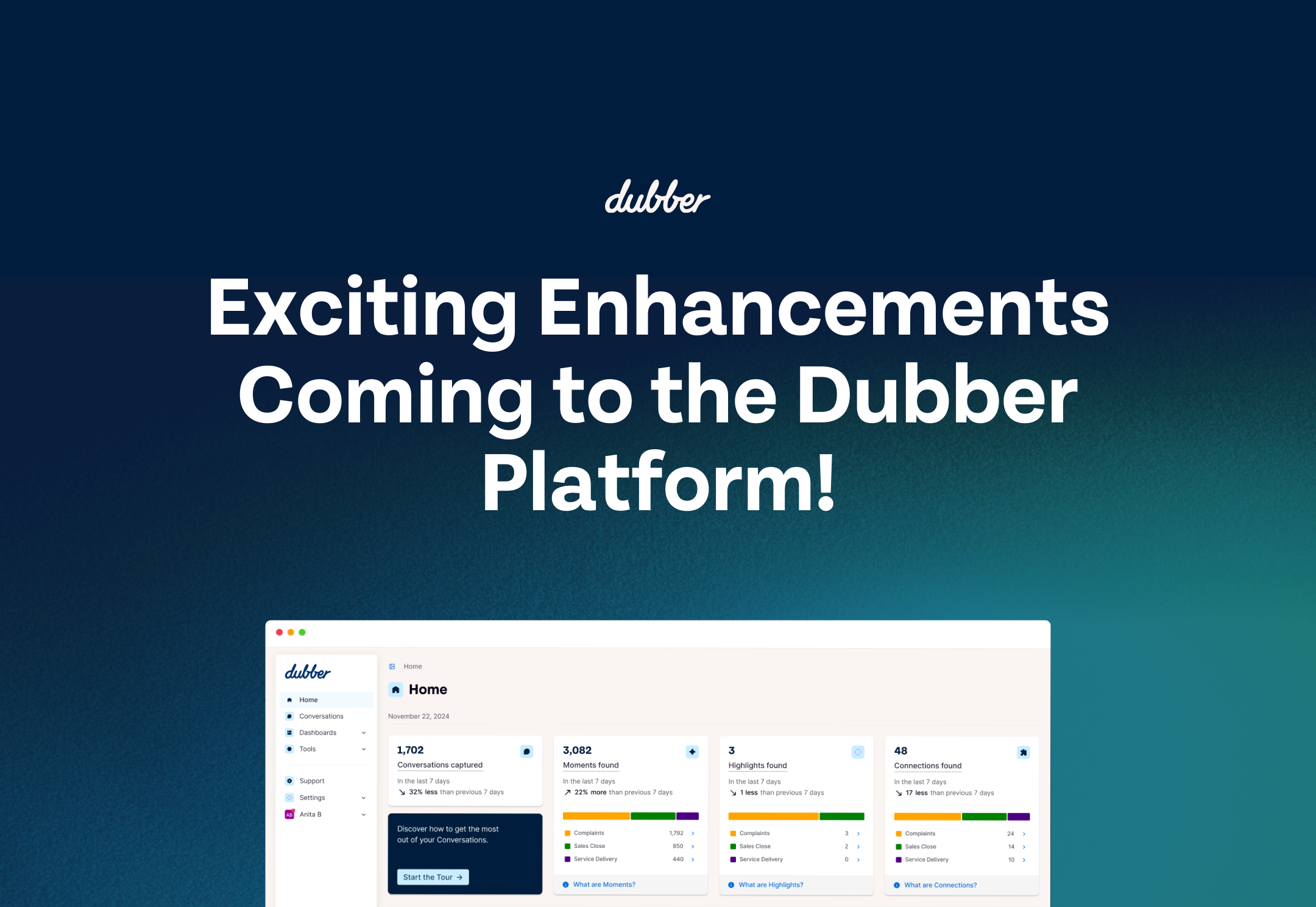
Dispersed workforces, remote call centres, and increasing customer and employee connections across mobile devices. These are just a few of the impacts of COVID-19. Hallway conversations, listening in, and on premise systems once gave leaders some insight to the conversations taking place between employees, customers, and suppliers. For many that has become difficult, if not impossible. Costly and limited on-premise call and conversation capture can’t keep up. A move from legacy call recording to the cloud has become a priority.
With a remote workforce, enterprises are asking how to capture crucial conversations. The number of IP connections has grown rapidly with more calls occurring remotely than on premise. However, regulatory demands remain in place: requiring secure, long-term storage of calls. Enterprises are looking for keyword reporting, sentiment analysis, and accurate and accessible transcriptions to quickly view call data, and receive custom alerts.
Accelerating to the cloud
This change is reflected in the broader shift to cloud-based solutions. Where this was once part of a longer-term digital transformation strategy, it has now become accelerated. 93% of IT decision makers are moving their cloud adoption programmes forward. Budgets will be shifted towards cloud solutions that facilitate our new way of working, with 52% seeing an increase due to the pandemic.
Optimised for remote work
We created Dubber to enable any business conversation to be captured and converted to actionable insights, no matter where it takes place. We couldn’t have imagined a scenario like COVID-19, where a dispersed workforce would make cloud call recording so critical.
With automated provisioning and no need for on-premise equipment or management, we make it easy for businesses looking to move to the cloud. We can even migrate historic recordings to cloud storage to ensure minimal risk and disruption as this change takes place. From then on, businesses can be assured that their communications can continue as normal, no matter where their employees are working from.
Business insights from a dispersed workforce
While our cloud call recording means that compliance mandates can still be met regardless of where staff are working from, this is just the beginning. Our voice AI is where businesses see real value. They are identifying opportunities to reduce churn, sharpening investment decisions, and improving the quality of conversations with customers. All this from the data held within their voice calls.
Four voice data imperatives
- Call recording isn’t the answer. It’s an answer, but not the answer. Voice data remains one of the great untapped opportunities in the enterprise. To unlock the data within is where the answers lie.
- AI isn’t just a convenient buzzword. When talking about AI, most call recording vendors are referring to transcription. This is just the first step. The real imperative at the heart of Dubber is using AI to enable advanced analytics, workflow management, sentiment analysis, and more.
- Break free of application, storage and device silos. Legacy call recording platforms imposed high-costs, limited storage, and restricted call capture. This only gave enterprises a partial view of what was happening, and locked data into proprietary dashboards. Our open API, data exporter, and application integrations allow you to use call data across your business.
- Secure your voice data. We capture voice data at the network level, and secure it with market-leading technology. Recording to local storage or application clouds outside of your control is high risk. Your voice data is as important as any other data, and should be protected.
The voice data revolution is just getting started. Getting your voice data strategy right today sets you up for long-term success and will help bridge the distance created by COVID-19.

Dubber Annual Report 30 June 2020

Dubber to acquire CallN

Proposed issue of securities

Dubber goes live on Cisco Global Price List

Dubber raises $10m

Now more than ever, businesses are moving towards agile workforces that aren’t tied to a location or device. Infrastructure and operations leaders are looking to create perimeterless workplaces that enhance operations while maintaining high security standards.
As we have seen over recent weeks, digital business requirements have accelerated the adoption of cloud services in order to support remote workers. Cisco’s video-conferencing Webex service registered a record 324 million attendees in March, with usage more than tripling in the APAC region. With workers switching from office PCs, to laptops in their home office, to smartphones or tablets in their living rooms, businesses need to ensure that they can do their job, no matter the device. This changing work style is described as a perimeterless workplace.
Mobile access to business tools require appropriate security precautions to ensure that access to information is controlled. With users transitioning between devices, networks, and applications, it can be difficult to maintain a seamless experience. By migrating to the cloud, organisations can enable these new ways of working without the need for local networks or VPNs and still maintain security standards. The adoption of cloud services allows users to be productive across a range of devices.
Removing perimeters with the cloud
Dubber cloud call recording and voice AI has been designed with remote work in mind from the very beginning. We connect to service providers directly through their networks: capturing calls directly from the source and securely storing them in the cloud, with no need for any on-premise equipment. With no up-front investment required, companies can access our call recording and voice AI services on an affordable monthly subscription. Businesses of all sizes can connect to our services through their telecommunications provider, with no minimums to prohibit smaller firms or self-employed workers. With global data centres, recorded calls are protected by the latest cloud security protocols while maintaining data sovereignty. Not only can calls be captured across fixed-lines and mobiles, with the appropriate permissions they can be securely accessed from any device or location.
Access and security permissions
In order to ensure information security, access management must be put in place for remote workers. Traditionally, access to data may have been restricted to internal networks within offices or corporate-owned devices. Within a perimeterless workplace, access is granted to specific users through authentication, authorisation, and single sign-on.
Within the Dubber platform, permissions settings and team structures are put in place to restrict access to recorded call content. Depending on the permissions status of the user, they may be able to listen to no call content, only their own calls, or the calls of their team. You can read more about our security practices on our security page.
Application integrations
Users working across devices and locations expect a seamless experience. They want to be able to use the same applications wherever they are working. This is why we made the Dubber portal available to use as a mobile app, desktop app, or through a web browser. Our open API also allows for integration with existing business tools, allowing recorded content to be accessible from applications that users already feel comfortable with. Integrations with CRM systems enable organisations to create detailed customer profiles with recorded calls and their transcripts stored alongside other information.
For more information on how our cloud services can be implemented across a remote workforce, talk to one of our team today.

Unifying your business communications is more important than ever before. With the COVID-19 pandemic disrupting working practices, and telecommunications services providers such as Telstra beginning to disconnect older technologies such as ISDN services in Australia, many businesses may be thinking about migrating to a scalable unified communications solution in order to remain connected.
It is expected that cloud communication solutions will replace services such as ISDN, offering significant savings and flexibility for businesses. Voice services will be easier to manage remotely, and the same communications can be deployed across multiple locations for greater integration and resilience. Connecting through the cloud, rather than physical phone lines, frees employees to work remotely. Cloud solutions also allow for omnichannel communications, which are particularly important for businesses as customers increasingly expect to be able to contact companies by a variety of methods.
What is ISDN and why is it being shut down?
The first telephone networks, built in the 19th century, were made of copper phone lines that sent voice data. This technology makes up the public switched telephone network (PSTN), which has been used ever since. The integrated services digital network (ISDN) uses these copper wires to digitally transmit voice and data.
In Australia, the National Broadband Network (nbn™) is superseding older technology such as ISDN. The nbn™ is a nationwide project funded by the Federal Government. The project aims to provide every home and business with fast and reliable internet with the intention that any new telephone networks will now be IP (internet protocol) based. While this means that traditional devices that do not support IP services will not be compatible, there are many benefits to embracing this new technology. Similar initiatives are taking place around the world.
Will my business need to change phone system, and what are the options?
Businesses with ISDN phone systems will need to make some changes, but these needn’t be drastic. In fact, the shutdown can be seen as an opportunity to upgrade organisational communications and save money at the same time. A transition to next-generation communications has the potential to increase flexibility as well as introduce greater functionality.
Many existing phone systems are compatible with SIP (session initiation protocol) solutions, which also allow organisations to add lines as required without the need for additional infrastructure. SIP channels, sometimes called SIP trunking, are easy to set up: the only requirement is a reliable internet connection with the bandwidth to support voice services, creating a virtual telephone line. A hosted IP phone system is a commitment-free alternative to an on-premise phone system. These solutions use an internet connection to provide the usual functionality of a phone system, without the maintenance charges associated with an on-premise system.
VoIP (voice over internet protocol) systems are hosted in the cloud, and are easy to install and maintain as they don’t require physical hardware. These systems use the internet to carry voice data, without on-premise equipment. VoIP doesn’t even require physical phones: softphones can transform a computer into a phone using software.
Future proof your business
While moving your communications to an entirely new solution may sound daunting, the benefits well outweigh any short term (and mild) inconvenience. Modern voice technology like SIP and VoIP can offer huge savings, as well as greater flexibility, scalability, portability, and security. Soft clients on devices enable workers to take all the capabilities of the office with them, wherever they go. Where traditional phone lines required installation in new locations, with IP-based services telephone lines can be easily added and removed, and can be of a higher quality. This future-proofs businesses for any growth, as handsets and portable devices can be connected instantly.
VoIP systems enable mobility through single number reach, allowing users to be reached on one number across multiple devices. VoIP can also incorporate a range of communication methods, such as video conferencing, email, and instant messaging into one solution. This consolidation of communication is referred to as unified communications (UC). Unified communications can bring cost savings and facilitate increased productivity, with users able to work from any location with an internet connection.
VoIP also provides greater potential for business continuity, as it’s not tied to any on-premise hardware. Calls can be diverted easily between locations in case sites are unreachable. UC that is completely hosted in the cloud is referred to as unified communications as a service (UCaaS). A whole range of communication and collaboration applications and services can be deployed through the cloud, and consolidating these services can often simplify billing into a fixed package; making costs more predictable.
To find out more about the kinds of services we offer that can be integrated into a UCaaS solution, get in touch with a member of our team today.

Dubber and Verizon align to add Call Recording and Artificial Intelligence (AI) Service into Verizon Virtual Communications Express (VCE)
How often do businesses ask their customers what they want? The people who use products and services are a valuable source of information for product development or business direction. Many businesses spend thousands of dollars on external market research, but what if companies already had these customer insights? Customers call a business for two main reasons: when they want answers, and when they are unhappy. These are rich sources of insights for companies looking for ways to improve their business. If organisations were to turn to their customer calls, they might uncover the secrets to success.
Increasing self-service
Customer phone calls are a great place to start when trying to understand what people want or need from a business. Aggregating the key themes from this call data allows businesses to cater to these needs through other communication channels. Data analysis of customer calls can identify common questions that can be answered on the company website or even programmed into chatbots, leaving more resources to deal with more complex queries. With huge amounts of voice data captured within phone calls, there is a rich mine of untapped insights that can inform FAQ pages and anticipate common queries through statistical analysis such as topic modelling.
Preventing complaints
Another area holding great potential for business improvement is customer complaint calls. If businesses understand why customers are calling they can prevent those issues. With Dubber AI, calls are rated by sentiment — giving a positive, negative, or neutral score for each section of the conversation and the entire call. Businesses can isolate negative calls to better understand the concerns or issues that customers may have with their products, services, or experience. Common problems can be identified and prioritised for improvement, preventing future complaints, leading to happier customers and reducing churn.
Dubber AI and Automated Alerts
Not only does Dubber AI help businesses learn from the historical data held within their calls and allow them to identify trends and common issues, with new automated alerts, designated users can receive custom notifications about their calls. Alerts can be created to notify users when calls with a certain sentiment rating have been made, allowing businesses to know as soon as a customer has had a bad experience so they can follow up immediately. Keyword alerts can also be customised to notify users when a specific word or phrase has been spoken on a call. Potential churn candidates can be identified when a competitor name is mentioned, and alerts can also be set up for specific callers so that VIP customers trigger a notification.
Want to learn more about how Dubber AI can identify business improvements? Talk to a member of our team.

